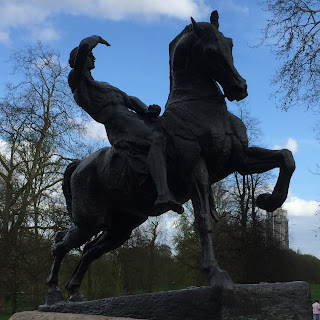Tour 11 Kensington Gardens
Queen Victoria
It was Queen Victoria’s daughter Princess Louise who designed the white marble statue of her mother in coronation robes adjacent to the Palace where she was born in 1819 and from where she acceded to the throne in 1837 at the age of 18. Victoria had sad memories of the Palace with the early death of her father and the strict regime imposed on her there by Sir John Conroy, her mother's domineering comptroller of the household. Victoria swiftly left Kensington Palace for Buckingham Palace granting apartments there to her family. Though today primarily a museum it still accommodates royals such as Prince William and his family.
Sunken Garden
Walking on either of the paths adjacent to Queen Victoria’s statue towards the Palace gain free access to the beautiful Sunken Gardens. Though in their present form just over a century old they trace back to the reign of William and Mary (1689-1702) from Holland who commissioned a palace garden of formal flower beds in the Dutch style to make them feel at home. Queen Anne (1702-1714) built the adjacent Orangery with a greenhouse to protect her citrus trees from frost. Today’s Sunken Garden has colourful flower displays in rotation throughout the spring and summer.
Italian Water Gardens
From her daughter’s statue of her pass to her husband’s gift to Queen Victoria of the Italian Water Gardens by heading diagonally across Kensington Gardens with the Round Pool on your right. Prince Albert had introduced a similar Italian Garden scheme at Osborne House and wanted to provide his wife with a reminder of their cherished Isle of Wight. The couple’s initials can be seen on a wall of the Pump House at the top of the splendid ornamental water garden with its terraces, statues, urns and shaped flower beds that are easily accessed from nearby Bayswater.
Peter Pan
From the Italian Gardens head south with Long Water on your left to Peter Pan. The Scottish novelist J.M.Barrie (1860-1937) created ‘the boy who wouldn’t grow up’, after his brother died ice-skating the day before his 14th birthday. Kensington Gardens most famous fictional character is symbol of youthful innocence and escapism. The statue links fact and fiction as its situated exactly where Peter lands his bird-nest boat from the Serpentine in one of Barrie’s stories. These run riot about how fairies, animals and other beings that have to hide in daylight move freely at night. The bronze statue of Peter Pan (1912) is surrounded by squirrels, rabbits, mice and fairies.
Physical Energy Statue
Continue south from Peter Pan along Long Water and take the first right turn towards a much larger bronze statue at the major path junction of a man on horseback called Physical Energy by George Watts (1817-1904). It is meant in the artists words as ‘a symbol of that restless physical impulse to seek the still unachieved in the domain of material things’. The figure scanning the horizon looking for new challenges represents human need for new challenges and the instinct to scan the horizon and look towards the future. There are copies of this statue in Cape Town and Harare.
Albert Memorial
From the Physical Energy statue walk down to Queen Victoria’s most visible legacy, the towering memorial to her husband Albert. His gilded figure, often sparkling in the sun, sits enthroned central to a monument based on Tombs in Verona. Albert’s death from typhoid in 1861 shook the nation and cast Victoria into deep mourning for the rest of her life. The mosaics and sculptures commemorate ‘a life devoted to the public good’ in arts and science. Christian virtues are represented on the canopy over the statue - faith, hope, charity, humility, fortitude, prudence, justice and temperance - with gilded angels raising their arms above these allegories to the gold cross of Jesus Christ.
Albert Hall
Prince Albert’s decorative memorial faces the practical one. The Albert Hall has a capacity of up to 5,272. The mosaic frieze below its dome depicts ‘The Triumph of Arts and Sciences’ with the inscription above: ‘This hall was erected for the advancement of the arts and sciences and works of industry of all nations in fulfilment of the intention of Albert Prince Consort. The site was purchased with the proceeds of the Great Exhibition of 1841 …. The wise and their works are in the hand of God. Glory be to God on high and on earth peace’. Return to the bus stop via the path to the left of the Round Pond.











Comments
Post a Comment